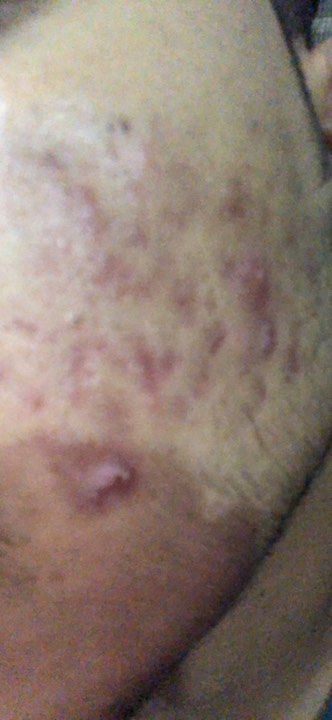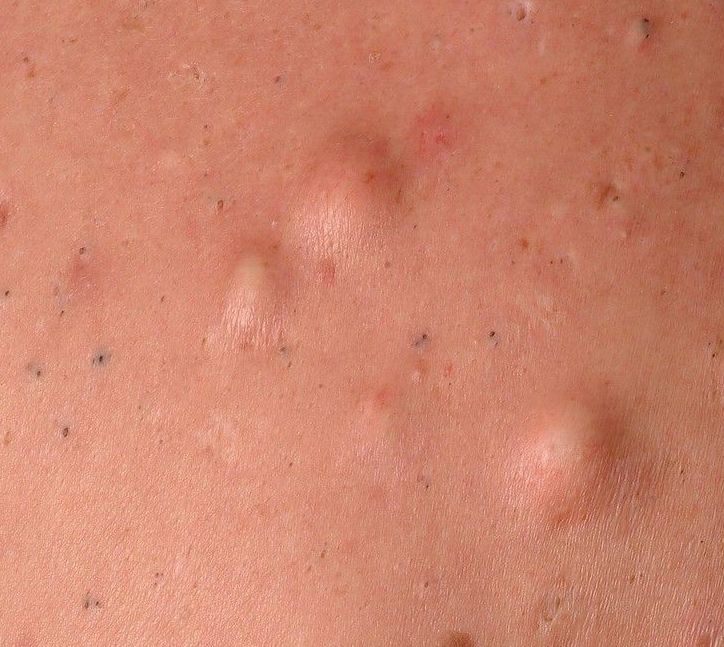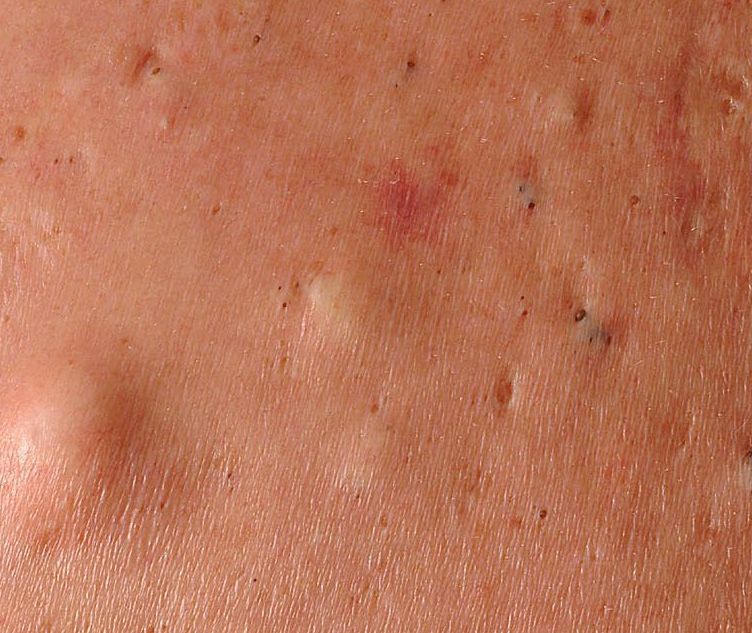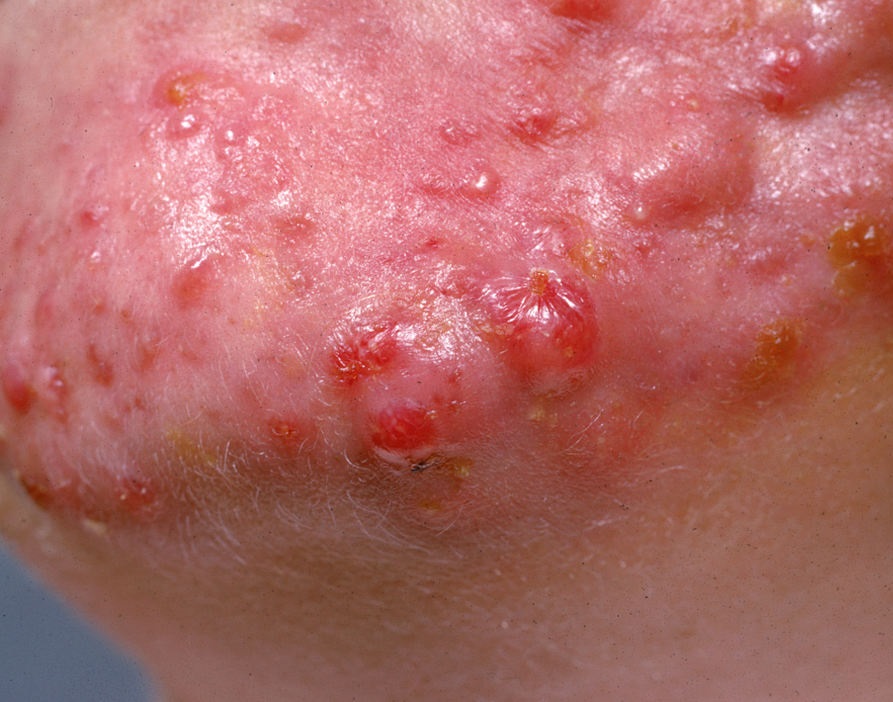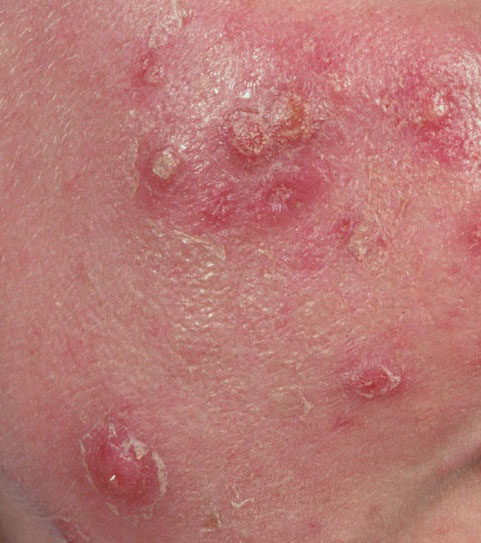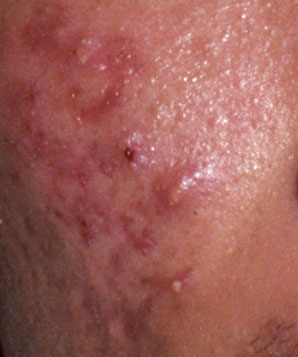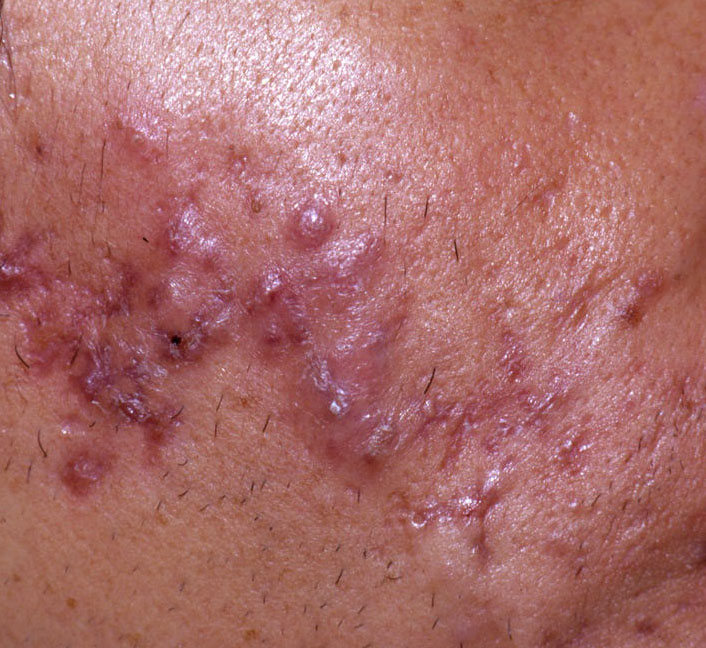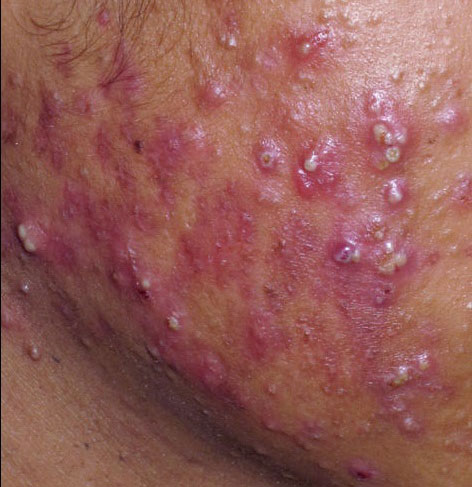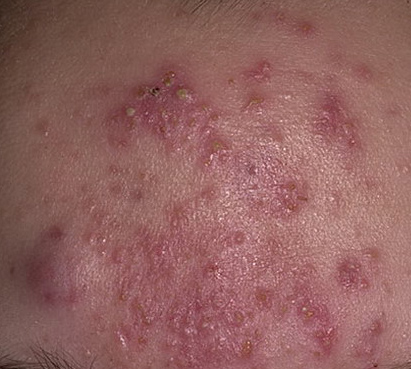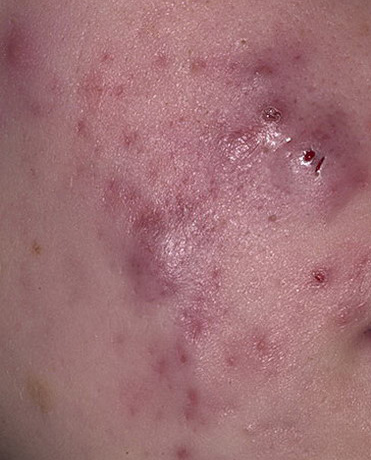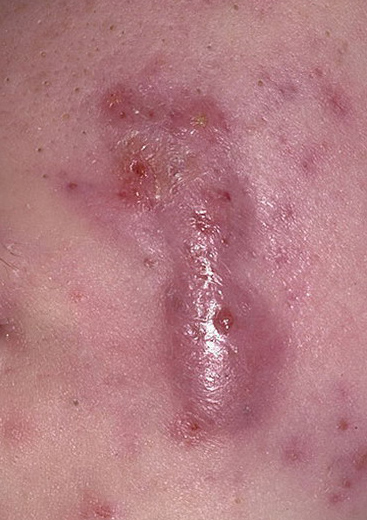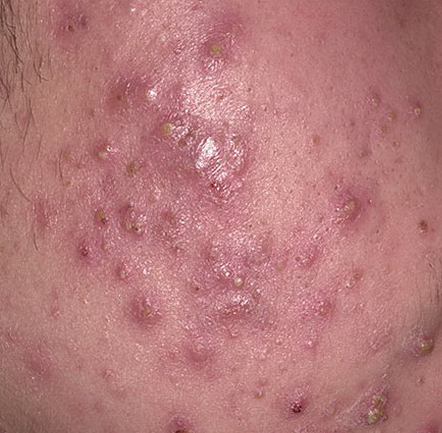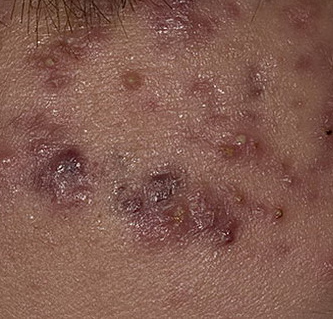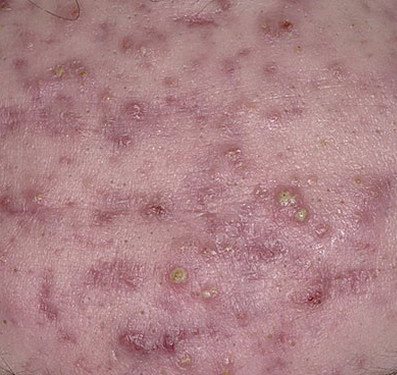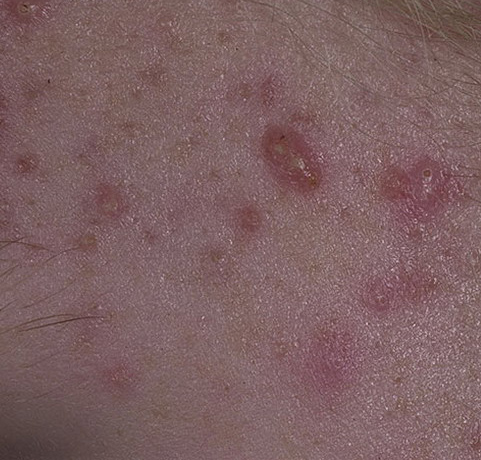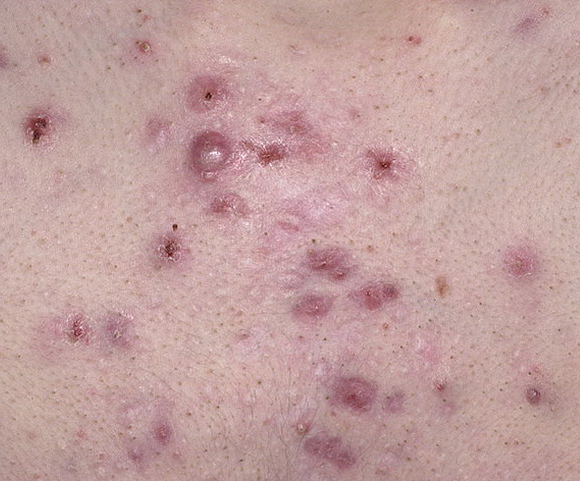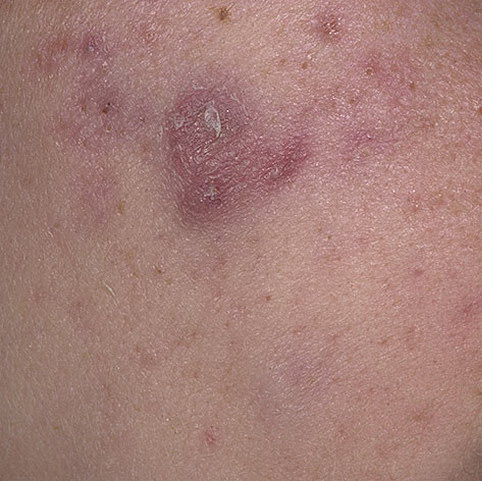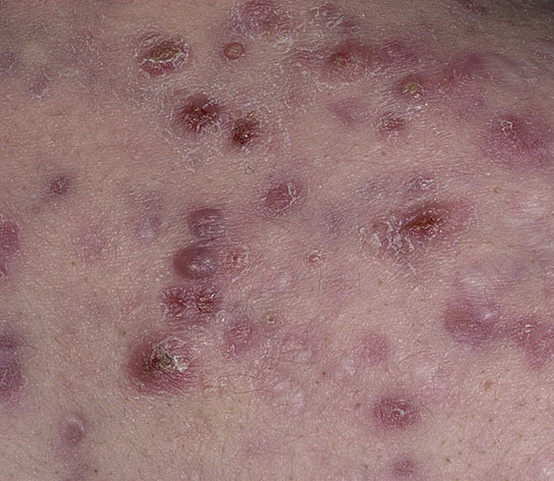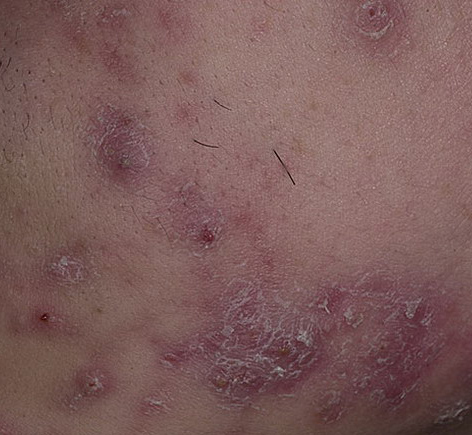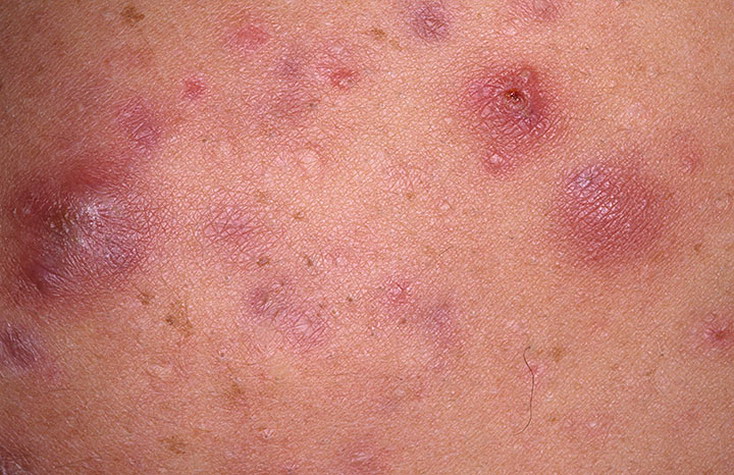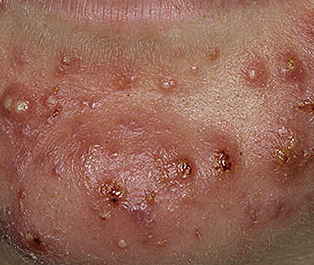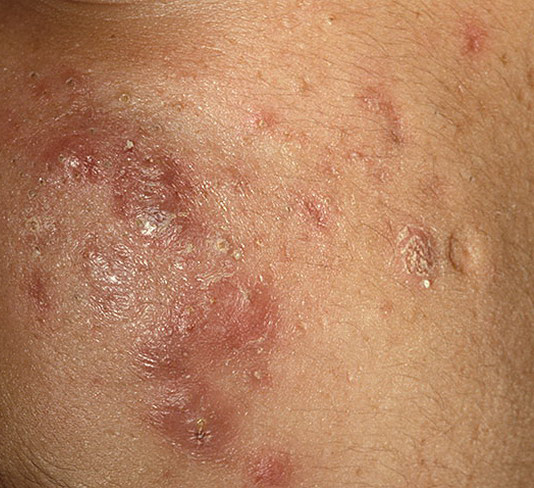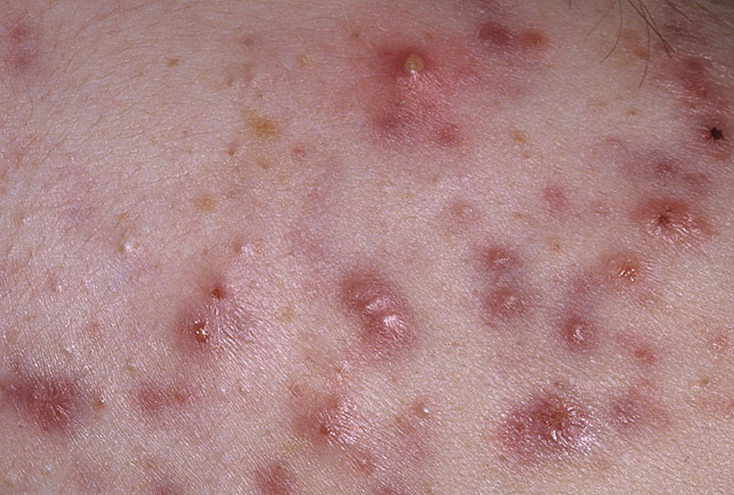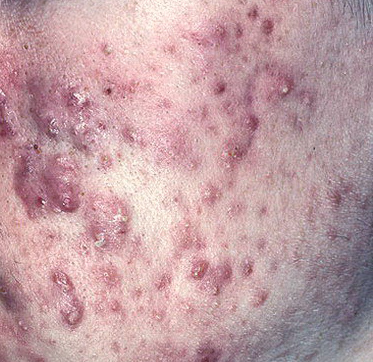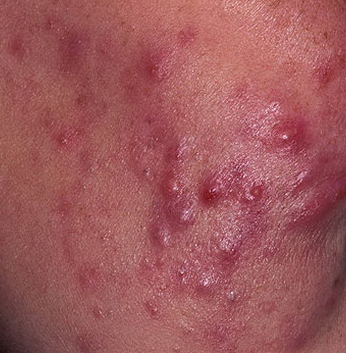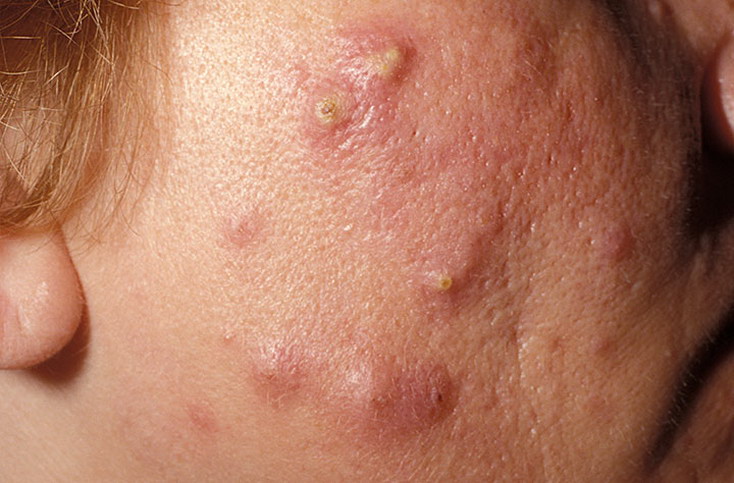Cystic Acne is a severe chronic inflammatory skin disease with primary damage to the sebaceous glands and hair follicles and the spread of the pathological process to the deeper layers of the skin. With cystic acne, elements such as comedones, papules, pustules, nodules, cysts, scars, and foci of hyperpigmentation are determined. The most typical localization of the rash is the face (forehead, cheeks, chin), chest area, back, shoulders.
Acne usually occurs in adolescence, from 11-13 years old. In males, acne appears a little later (the debut can be observed in 19-20 years), but is more common. In girls, on the contrary: the first signs can be noted as early as 11 years old, but it is less common compared with the male sex.
The prevalence of acne is very high. It is believed that this disease is found in 80% of the population. However, due to the absence of special health threats, not all patients seek medical help, perceiving this skin condition only as a cosmetic defect and not taking proper measures to eliminate the problem.
The formation of acne is associated with excessive secretion of sebum by the sebaceous glands. The second condition is a blockage of the excretory ducts of the sebaceous glands with the accumulation of secretion in them and the appearance of comedones. These two steps are enough for the development of non-inflammatory acne. If microflora begins to actively multiply in comedones (for example, Cutibacterium acnes – a representative of the normal microflora of a person), followed by the formation of an inflammatory reaction in this place, an inflammatory form of acne develops.
Predisposing factors
There is no specific reason for the appearance of acne. This is a multifactorial disease, in the development of which many different pathological conditions and changes both inside the body and outside it take part.
Today it is believed that heredity makes the main contribution to the launch of the pathological chain of acne formation. This is confirmed by scientific research, including observations of the twins. A number of genes that increase the risk of acne are already known.
Other predisposing factors that can affect the formation of acne to varying degrees include:
- Endocrine processes – primarily this is confirmed by the age of acne debut. It is during puberty in the body that intense changes in the hormonal background are observed. The main connection is found between acne and androgens – male sex hormones that stimulate the growth of sebaceous glands and activate the secretion of sebum;
- The role of microorganisms, in particular Cutibacterium acnes. Despite the fact that this is a normal microflora of the human skin, in certain cases, it can also provoke inflammatory processes. Of course, the addition of pathogenic skin infection, as well as the Demodex tick, can lead to acne;
- Problems with personal hygiene, improperly selected or poor-quality cosmetics, the influence on the skin of external factors (especially physical ones – chronic injuries with clothes or professional devices) – can provoke the appearance of acne, having a negative impact on the normal functioning of the skin as an organ;
- Decreased body defenses against stress, immunodeficiency, poor environmental conditions, the appearance of bad habits, deficiency of vitamins, macro and microelements, poor nutritional quality;
- The nutrition factor plays a special role. Acne is often observed in adolescents, whose food contains a large amount of sugar, chocolate, coffee, dairy products. Similarly, eliminating or limiting these products can help you deal with acne more quickly and easily. At the same time, there is no scientific evidence describing the direct and reliable relationship between the listed foods and acne.
Diagnostics
The diagnosis of acne is based on history and clinical examination. A carefully collected history allows you to find out the time of onset of skin disease, conditions, course. A clinical examination reveals typical elements characteristic of acne. If such a need arises, especially in the presence of single elements, unexpressed manifestations, dermatoscopy can be performed.
A thorough diagnosis is necessary to correctly determine the severity of acne, as well as the maximum detection of provoking factors. All this allows in the future to choose an adequate treatment and individually form preventive measures.
Symptoms
A visual examination of cystic acne determines a skin rash that includes all the main elements of acne: comedones, papules, pustules, nodules, cysts. The proportion of each element may be different, but a distinctive symptom is the presence of deep skin cysts.
Comedones – can be closed and open. Closed comedones are slightly elevated, whitish, or the color of ordinary skin, painless, dense formations. Their diameter at the base does not exceed 1-3 mm. The surface is represented by normal skin or slightly smoothed. Open comedones are distinguished by the presence on the surface of the recess and a black dot in it – this is an oxidized sebum plug from sebum in the open air. Open comedones can reach sizes up to 5-7 mm, especially on the back.
On the surface of the recess and the black dot in it, this is an oxidized sebum plug made of sebum in the open air. Open comedones can reach sizes up to 5-7 mm, especially on the back.
A papule is a common pimple without contents inside: slightly elevated, pink-red, or red, painful on contact with fuzzy borders. Their diameter at the base does not exceed 1-3 mm. The hyperemic skin reaction around the pustule can reach 10 mm in diameter. In the presence of severe inflammation, the papule may be denser than normal skin. The surface is represented by normal skin or slightly smoothed.
Pustule is a common pimple with a whitish or yellow tint inside. It is slightly elevated, pink-red or red on the periphery and whitish in the center, painful on contact, with fuzzy borders. The pustule is usually denser than the surrounding skin. The diameter in the base does not exceed 1-3 mm. The hyperemic skin reaction around the pustule can reach 10 mm in diameter. The surface is usually smooth, especially in the center. When squeezed, the pustule is opened and structureless white contents stand out from it.
Nodules are papules, but with a more pronounced inflammatory reaction, larger, denser, located deeper in the skin, more painful. After resolving the acute process against the background of nodules, the likelihood of scarring is higher. With progression (suppuration) – cysts form on the background of nodules.
Cysts are festering nodules: painful, dense subcutaneous masses up to 10 mm in diameter, with a large number, or close proximity, can form larger conglomerates. In the area of the cyst, the skin is hyperemic, swollen, with signs of cyanosis. Above long-existing cysts, the skin becomes thinner until the fistulous course forms with the contents coming out.
With cystic acne, especially in long-existing forms, after repeated healing and relapse, scars and local foci of hyperpigmentation can be determined.
Scars – formed after the healing of acne elements deep in the skin. The likelihood of scarring increases according to the severity of acne. Scars can be atrophic (more common) and hypertrophic. Atrophic scars – a deepening in the skin with clear boundaries, with little or no change in the density of the skin and its pattern, but larger in diameter than the size of the original element. Hypertrophic scars – protruding above the skin, rough, dense formations, usually correspond to the diameter of the original element.
Foci of hyperpigmentation – a post-inflammatory enhancement of the color of the skin, which forms, like scars, after the disappearance of the original elements of acne. Foci of hyperpigmentation can exist separately or in combination with scars (in this case, they indicate the presence of a pigmented scar). Pigmentation is a variety of shades of brown in color.
Favorite localization of acne is the area of the face, especially the forehead, cheeks, and chin, as well as the area of the back (mainly the scapular area), the area of the chest, and shoulder joints. For other anatomical areas, the appearance of acne is not characteristic.
Differential diagnosis
Differential diagnosis is carried out with diseases such as:
- Different degrees of severity and form of acne;
- Rosacea;
- Isolated comedones;
- Milium;
- Dermatitis
- Acneform rashes and dermatoses;
- Medical acne;
Against the background of severe forms of acne, especially in adults, there are nodal forms of basal cell carcinoma and pigmentless melanoma.
Risks
Cystic acne does not pose a major threat to the physical health of a person. At the same time, the presence of this pathology may indicate the presence of some rearrangements in the body: from physiological (such as puberty) to pathological (metabolic disorders, decreased immunity). Being a kind of mirror, a reflection of the internal state of the body, the appearance of acne cannot be ignored, it is necessary to conduct a thorough search for the causes and provoking factors. This will contribute not only to the effective treatment of acne, but also to the timely search for other, possibly more serious diseases.
On the other hand, acne can cause a significant cosmetic defect and psychological damage to the patient. To avoid severe consequences from these problems, acne treatment should be multicomponent with the involvement, if necessary, of various specialists (dermatologists, cosmetologists, nutritionists, endocrinologists, psychologists).
In the absence of timely treatment, the progression of acne leads to severe infectious skin lesions with a risk of generalization of the infection with corresponding complications. In addition, elements of severe acne can be injured, ulcerated, followed by bleeding.
Tactics
When the first signs of acne appear, as well as with the progression of existing forms, the ineffectiveness of the previously prescribed treatment, a visit to a dermatologist is shown.
The initial visit to a specialist is most important, since it is necessary to carry out the whole complex of diagnostic measures with the subsequent appointment of individual treatment.
An immediate visit to a specialist is indicated if there is mechanical damage to the skin in the acne area, as well as if any changes in the appearance of one of the elements are noticed or previously absent sensations appear.
Acne is a chronic pathology, lasts a long time, for many years, with periods of exacerbations and improvements. The course of the disease may depend on various factors occurring in a person’s life, therefore close contact with a specialist should be maintained, with the help of which a timely and adequate response to changes in the skin will be carried out.
It is important to recognize the need for preventive consultations on acne management, especially before the upcoming changes in life: choosing a diet and lifestyle, before changing your usual cosmetics, planning trips to areas with a different climate, changing your place of work with a different microclimate, and also when starting other treatment affecting the human endocrine system.
Treatment
Acne treatment is multicomponent and individual. Includes:
- Drug therapy;
- Local cosmetic treatment;
- Phototherapy;
- Physiotherapy
- Correction and elimination of provoking factors;
- Treatment of concomitant pathology;
- Therapy aimed at reducing emotional distress.
In the treatment of cystic acne, a complex of systemic and local antibacterial therapy is usually prescribed. Local anti-inflammatory and wound healing agents are also used. Hormone therapy or other groups of pharmaceuticals can be prescribed for treatment, however, there must be clear and unambiguous indications for this.
In order to normalize the life cycle of cells of the upper layers of the skin, to ensure normal processes of keratinization and desquamation (exfoliation of the upper layers of epithelial cells), topical retinoids are prescribed, as well as a cosmetic treatment. The mechanical extraction of comedones using special devices can also be used.
To stop the inflammatory process, local anti-inflammatory drugs, physiotherapy, and phototherapy are used.
After the elimination of acute processes and the appearance of scars, various methods of laser resurfacing, and dermabrasion, other cosmetic procedures aimed at eliminating this defect are used. Rough scars that are not amenable to conservative treatment can be removed by plastic surgery.
It is important to understand that there is no single miracle remedy that can, in a short time, quickly, without consequences, and absolutely for every person to help in the fight against acne. That is why you need to be critical of advertising such funds and self-healing them. Any new drug should be discussed with a specialist.
Also, in the treatment of acne, you need a clear systematic approach and commitment to follow the recommendations. Independent deviation from the prescribed treatment regimen, interruption, and non-compliance with therapeutic regimes significantly complicates the achievement of the expected effect.
At the same time, it is necessary to understand the risk of treatment failures, accepting that the prescribed therapy does not always have the desired effectiveness and speed of achieving results. There should be a readiness for an open dialogue with a dermatologist, tolerance for a possible change in treatment approaches.
Prevention
Prevention of acne consists of a gentle and careful attitude to the skin, timely treatment of infectious diseases, strengthening immunity, proper and high-quality personal hygiene, in maintaining a healthy lifestyle, especially in terms of nutrition.
To exclude negative consequences and complications, it is necessary:
- Limitation of ultraviolet radiation (tanning bed, suntan);
- The use of protective creams during periods of active sun;
- Exclusion of chronic skin trauma;
- Limitation or exclusion of ionizing radiation, occupational hazards;
- Compliance with safety measures when working with skin-damaging factors;
- Personal hygiene and basic skin health awareness.
It also requires regular inspection of the skin, timely consultation of a dermatologist when any changes on it appear.
